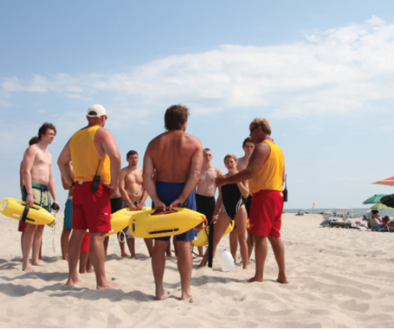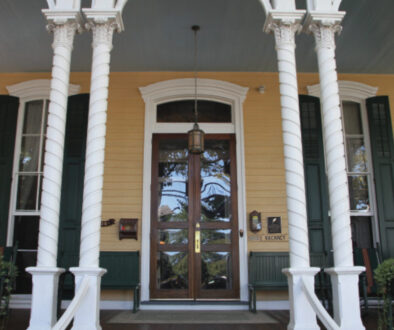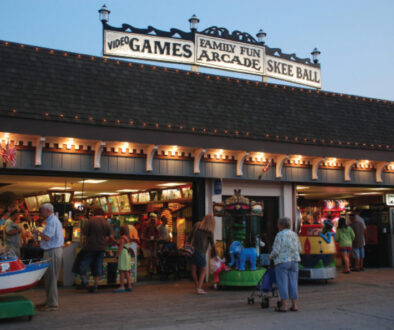The Beaten Track

When a November 2014 storm uncovered a span of railroad track at Sunset Beach, people were surprised. Few knew why train tracks would even be there, or about the forgotten role of trains in Cape May’s history. Across much of the nineteenth and twentieth centuries, trains made a huge impact on our country’s history and significantly factored in Cape May’s many economic ups and downs. Trains were critical to Cape May industries from after the Civil War until October of 1981, when train service was discontinued.
Packet boats and steamers established Cape May as a premier seaside resort and began the City’s relationship with Philadelphians. Trains were just a vision in the early 1800s but in 1852, Dr. Jonathan Pitney and an investor group obtained a railroad charter and jointly established both a new resort named Atlantic City, and the Camden and Atlantic Railroad between Absecon Island and Camden. The Atlantic City railroad reduced Cape May’s tourist business. The train to Atlantic City was novel and took only a few hours rather than the almost full day required to get to Cape May by boat. But, in spite of the potential advantages, train travel to Cape May did not bec ome a reality until the summer of 1863 after much arguing and bickering among leaders, residents, and investors. Then, even as now, City leaders viewed the resort’s future within a conservative and cost-conscious lens.
Throughout the 1850s, local newspapers printed pros and cons about the benefit of train travel to Cape May. Many year-round Cape May citizens had substantial financial interests in the boat transportation industry as owners, investors, and employees; others held land and jockeyed for tracks to be laid over their property. But in the end, worry about the decreasing number of summer visitors and the town’s tourist industry prevailed. The train ultimately changed Cape May, catapulting the resort back into prominence as a worthy competitor with more accessible East Coast resorts like Atlantic City. Many potential investors believed that train travel would create demand. These investors took advantage of opportunities in the City such as trains, streetcars, speculation houses, hotels, and summer cottages—all of which were especially appealing to Philadelphians who had realized recent financial benefit from profitable war industries. The completion of the train to Cape May resulted in significantly increased property development and shifted almost all Cape May investment from local owners to primarily Philadelphian investor-owners. Over time, year-round residents lost control of the summer economy, although government and municipal control was retained.

The train itself was the first investment shift. Eleven years of discussion and reformulation of companies resulted in train lines from Camden to Millville, but insufficient funds prevented extending the line to Cape May. Finally, investors Richard Wood from Philadelphia and Millville and the Whitney Brothers, glassmakers from Glassboro, funded the Millville to Cape May railroad, which allowed train travel from Philadelphia (Camden) to Cape May. In 1869, these lines were consolidated into the West Jersey and Seashore Railroad, resulting in one line that flourished for a century until automobiles became the preferred way of travel.
Train travel gave birth to new ways of accommodating those visitors who were not staying for the season or fairly long periods of time, as had been the case before the Civil War. With this faster travel came the one-day visitor, the excursionist or day tripper, often, even today, negatively labeled as a “shoobie,” a term reportedly coined because one-day visitors carried their lunches with them in shoe boxes. Excursionists were a new breed of Cape May visitor. Reports in the local papers included comments about how excursionists took up space on hotel porches, in drawing rooms, and in other facilities, crowding out paying guests. The only real benefit of one-day excursionists was to the railroad.
The West Jersey Railroad invested heavily in Cape May in order to increase train travel. The first of their Cape May investments was the Sea Breeze Excursion House, situated on the beachfront to the far west of Grant Street. Opened in 1868 and designed for the one-day excursionist, the house could accommodate up to 1,500 daily visitors on commodious verandahs and expansive drawing rooms. The Sea Breeze included washrooms and beachside bathhouses, a dining room, and even bowling alleys and billiard parlors for the excursionists to use during their one-day visit. Another scheme, lasting several years, gave free tickets to people who built cottages valued at more than $2,500.
But the most significant investment was the building of the Stockton Hotel, which opened in June 1869 with 475 guest rooms. Designed by Stephen Button for a reported $300,000 and situated on the beachfront between Gurney and Stockton Streets, the hotel featured the typical Cape May “L” shaped, columned hotel design, where most rooms faced the beachfront for maximum ocean views and sea breezes. The Stockton rapidly became one of the island’s most popular hotels, rivaling Congress Hall and other older and less fashionable hotels. It was so popular that a year after it opened, the Stockton Row cottages, situated today on the west side of Gurney Street, were built to provide additional summer accommodations. The Stockton was known for highly popular hotel bands, fashionable nightly balls, and banquets for special events. One 1898 Fourth of July celebration menu listed an appetizer of Cape May Salts, the forerunner to today’s highly valued local oysters.

But even with the railroad’s best efforts, by the early years of the twentieth century, Cape May had fallen into another slump and large hotels like the Stockton suffered. One of the few hotels in Cape May that was not destroyed by fire, the Stockton deteriorated and was purposefully demolished in 1910.
The West Jersey Railroad continued to promote and invest in the city despite an 1869 fire that destroyed a number of hotels and businesses. By 1876, business was so strong in the summer months that the Summer Station was built to offer an additional location for summer visitors other than the spur running alongside the Sea Breeze or the winter station located in the heart of the city at Jackson and Broad Streets where the Wawa stood in more recent years. The Summer Station was located on the west side of Grant Street along the beachfront. The tracks ran to west of Grant Street, joined with the Sea Breeze spur, and turned to the east, running along what we know today as Park Boulevard and crossing over the meadows where they met with the spur going into the city.
The Summer Station escaped the devastating 1878 fire which destroyed 25 acres of the central part of the city, slowed its continuing growth, and contributed to further loss of vacationers, who headed to Atlantic City and other shore communities. Even the early 1900s attempts of the Cape May Real Estate Company to develop the eastern part of the city as a Newport competitor were unsuccessful. Cape May fell asleep and slumbered, waiting for a reawakening that would not occur for 50 years.

By the 1890s, railroad travel was at its peak and a second line, the South Jersey Railroad, was run into the city. Tracks paralleled the West Jersey road with both railroads competing for Cape May’s travel business. Although at their peak these lines carried 1,500 passengers on an average summer day, as tourism declined neither had sufficient passengers, and by 1933 the two companies merged and became the Pennsylvania-Reading Seashore Line.
Even as passenger travel waned, railroads remained an integral link in the local economy, bringing raw materials for the small number of existing industries and transporting the county’s major products of seafood and produce to Philadelphia and other cities. The Cape May and Delaware Bay Railroad ran along the beachfront from the steamboat landing—near today’s Higbee Beach—to the Summer Station, sparing boat passengers the bumpy, dusty ride from the landing to the city. Another standard gauge train, the Sewell Point Railroad, ran along the beachfront to stops between the Summer Station and Sewell’s Point, where the Fun Factory and popular restaurants were located. By 1901, the two lines, purchased by two local businessmen, were combined into the Cape May, Delaware, and Sewell Point Railroad. Additional tracks were added for trolleys on several main streets.
Cape May figured prominently in both World Wars as the Navy maintained large facilities in the eastern part of the city and Lower Township. During World War I, the abandoned Fun Factory became transformed into a mess hall and sleeping quarters. The Liberty Special train transported Navy personnel to the Summer Station using the tracks of the Cape May, Delaware, and Sewell Point Railroad.

World War I also promoted a new but short-lived industry. Eugene Grace, a Goshen native who left the county to attend Lehigh University and rose to become president of Bethlehem Steel, established several ordnance testing grounds throughout the county, one of which extended north from today’s Higbee Beach along the bayfront to Reed’s Beach. The ammunition was transported to Cape May by train, then trucked to Higbee and carried for firing to the beachfronts on small-gauge trains. The Bethlehem Steel operations were adjacent to an earlier industry, the Cape May Sand Company, one of the few non-military industries established in Cape May. Begun in 1905, the company provided sand for construction. The sand was scooped up, washed, and then loaded into train cars that ran along the beach and into the city’s winter station to be transported north. It is possible that the recently uncovered train tracks may have originated with the Sand Company.
After the Bethlehem Steel testing grounds closed, the land remained vacant until World War II when it was purchased by the Harbison-Walker Refractories Company, a subsidiary of the Northwest Magnesite Company. The plant opened when blockades prevented imports of magnesite, a substance needed for the manufacture of fire brick for steel production. Synthetic magnesite was manufactured adjacent to the old Sand Company, and for many years, it was Cape May’s primary non-tourist industry. As with previous companies, the train lines running from Sunset Beach to the City were used to transport materials needed for magnesite manufacturing and to transport the product out of Cape May for use in making other products.
Both the magnesite plant and the Pennsylvania-Reading Seashore Lines discontinued operations in September of 1983, ending freight train services to Cape May and signaling the end to year-round employment industries that were not tied to tourism, fishing, or farming. In the decades to come, Cape May would become increasing more economically dependent on tourism.



